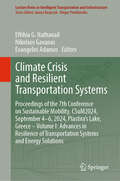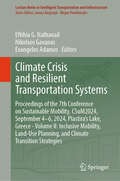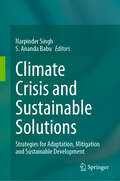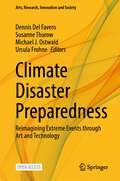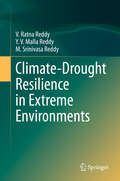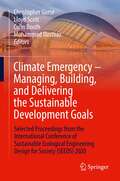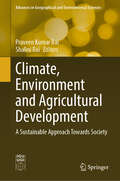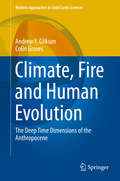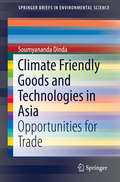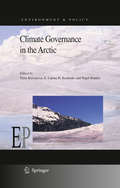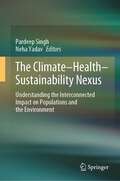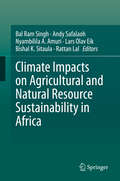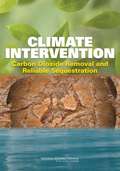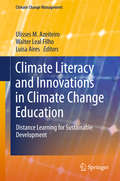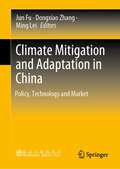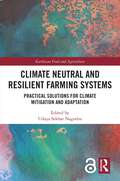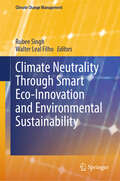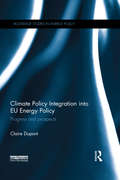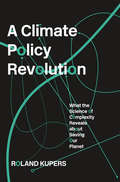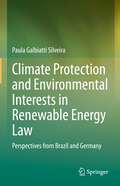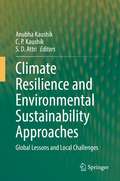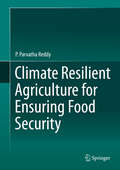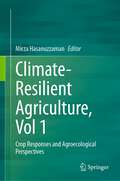- Table View
- List View
Climate Crisis and Resilient Transportation Systems: Proceedings of the 7th Conference on Sustainable Mobility, CSuM2024, September 4–6, 2024, Plastira’s Lake, Greece – Volume I: Advances in Resilience of Transportation Systems and Energy Solutions (Lecture Notes in Intelligent Transportation and Infrastructure)
by Eftihia G. Nathanail Nikolaos Gavanas Evangelos AdamosThis book reports on original research and practical findings fostering resilient and sustainable transportation systems in response to the climate crisis. Being the first volume of the proceedings of the 7th Conference on Sustainable Mobility (CSuM 2024), held on September 4–6, 2024, at Plastira’s Lake, Greece, it focuses on research and practical strategies for developing sustainable and resilient transportation systems, and guidance for their green and digital transition. All in all, this book offers extensive information to academicians, researchers, practitioners and decision makers working on effective strategies to enhance resilence of transportation systems.
Climate Crisis and Resilient Transportation Systems: Proceedings of the 7th Conference on Sustainable Mobility, CSuM2024, September 4–6, 2024, Plastira’s Lake, Greece - Volume II: Inclusive Mobility, Land-Use Planning, and Climate Transition Strategies (Lecture Notes in Intelligent Transportation and Infrastructure)
by Eftihia G. Nathanail Nikolaos Gavanas Evangelos AdamosThis book reports on original research and practical findings fostering collaborative, inclusive, just, safe and climate neutral transportation planning. Being the second volume of the proceedings of the 7th Conference on Sustainable Mobility (CSuM 2024), held on September 4–6, 2024, at Plastira’s Lake, Greece, it describes state-of-the-art models, techniques, and applications that enable the transition of transportation systems to support sustainable societies. All in all, this book offers extensive information to academicians, researchers, practitioners and decision makers working on effective strategies to transform mobility in a sustainable and equitable way.
Climate Crisis and Sustainable Solutions: Strategies for Adaptation, Mitigation and Sustainable Development
by Narpinder Singh S. Ananda BabuThis contributed volume dives into the critical intersection of climate adaptation, vulnerability to hazards, and the imperative of decarbonization in fortifying global food and nutritional security. This comprehensive exploration aims to shed light on the challenges our food systems face in the wake of climate change, and the strategies required to ensure resilience and sustainability. In the face of escalating climate challenges, securing sustenance demands a comprehensive approach. Climate adaptation becomes paramount, as agricultural systems struggle with increased vulnerabilities to various hazards. From extreme weather events to shifting precipitation patterns, the agricultural landscape is under constant threat. The decarbonization imperative emerges as a critical strategy, addressing the dual goals of mitigating climate change and enhancing food and nutritional resilience. By reducing carbon emissions and transitioning to sustainable practices, we not only contribute to global climate goals but also fortify food systems against environmental shocks. This integrated approach acknowledges the intricate connections between climate, agriculture, and nutrition, emphasizing the urgency of concerted efforts to ensure a resilient and sustainable future for food production and consumption. This book includes in-depth case studies from different regions, showcasing the diverse impacts of climate change on food systems. This book will integrate insights from multiple disciplines such as environmental science, agriculture, policy studies, and community engagement, providing a more holistic understanding of the issues at hand. It will serve as a valuable resource for students, researchers and practitioners seeking in-depth knowledge on these interconnected topics.
Climate Disaster Preparedness: Reimagining Extreme Events through Art and Technology (Arts, Research, Innovation and Society)
by Michael J. Ostwald Ursula Frohne Dennis Del Favero Susanne ThurowAs a result of global warming, extreme events, such as firestorms and flash floods, pose increasingly unpredictable and uncertain existential threats, taking lives, destroying communities, and wreaking havoc on habitats. Current aesthetic, technological and scientific frameworks struggle to imagine, visualise and rehearse human interactions with these events, hampering the development of proactive foresight, readiness and response.This open access book demonstrates how the latest advances in creative arts, intelligent systems and climate science can be integrated and leveraged to transform the visualisation of extreme event scenarios. It reframes current practice from passive perception of pre-scripted illustrations to active immersion in evolving life-like interactive scenarios that are geo-located. Drawing on the multidisciplinary expertise of leaders in the creative arts, climate sciences, environmental engineering, and intelligent systems, this book examines the waysin which climate disaster preparedness can be reformulated through practices that address dynamic and unforeseen interactions between climate and human life worlds. Grouped into four sections (picturing, narrating, rehearsing, and communicating), this book maps this approach by exploring the emerging strengths and current limitations of each discipline in addressing the challenge of envisioning the unpredictable interaction of extreme events with human populations and environments. This book provides a timely intervention into the global discourse on how art, culture and technology can address climate disaster resilience. It appeals to readers from multiple fields, offering academic, industry and community audiences novel insights into a profound gap in the current knowledge, policy and action landscape.
Climate-Drought Resilience in Extreme Environments
by V. Ratna Reddy Y. V. Reddy M. Srinivasa ReddyThis book assesses the effectiveness of changes in watershed interventions in one of the most fragile resource regions of India. Specifically the chapters examine various watershed centred interventions and their implementation process. An evaluation of the livelihood impacts, including crop production on the communities, is discussed and an assessment of the drought and climate resilience of households in the context of watershed and related interventions, including institutions and capacity of the communities, is investigated. Lessons are drawn to further identify measures to strengthen and improvise interventions for enhanced climate-drought resilience in harsh environments.
Climate Emergency – Managing, Building , and Delivering the Sustainable Development Goals: Selected Proceedings from the International Conference of Sustainable Ecological Engineering Design for Society (SEEDS) 2020
by Christopher Gorse Lloyd Scott Colin Booth Mohammad DastbazThrough research and proven practice, the aim of the International Conference of Sustainable Ecological Engineering Design for Society (SEEDS) is to foster ideas on how to reduce negative impacts on the environment while providing for the health and well-being of society. The professions and fields of research required to ensure buildings meet user demands and provide healthy enclosures are many and diverse. The SEEDS conference addresses the interdependence of people, the built and natural environments, and recognizes the interdisciplinary and international themes necessary to assemble the knowledge required for positive change.
Climate, Energy and Water
by Pittock, Jamie and Hussey, Karen and Dovers, Stephen Jamie Pittock Karen Hussey Stephen DoversWith the global population expected to reach nine billion by 2050, our capacity to provide enough food, water and energy relies on our understanding and management of the complex interdependencies in the climate-energy-water nexus. This book presents a comprehensive and up-to-date analysis of the interdependencies between these sectors and the knock-on consequences of those interactions for other sectors, such as food production and biodiversity conservation. The interdisciplinary nature of the book across the three sectors of climate, energy and water means that it will be valuable for advanced students, researchers and policymakers across a broad range of fields, including environmental/energy/water/climate policy, environmental economics, climate science, hydrology, ecology and geography.
Climate, Environment and Agricultural Development: A Sustainable Approach Towards Society (Advances in Geographical and Environmental Sciences)
by Praveen Kumar Rai Shalini RaiThis book discusses an emerging context of climate change, environmental degradation, monitoring and management, agricultural vulnerability and its development and adaptation from local to global scale. The book also describes the research methodology in a simple and lucid way so that a researcher can adopt it in his/her field studies. Individual chapters are dedicated to different subjects such as the quantification of climate change impacts on environment; land use land cover; crops in controlled and field conditions; water resources; soil fertility, erosion and carbon sequestration; insects, pests, weeds, microbes and diseases; greenhouse gas emission assessment; regional vulnerability to climate change; and selection of crop. Researchers from around the world and from various fields explore these important topics in the book. The book is a valuable resource for environmentalists, geographers, economists, agronomists, biologists, agricultural scientist, climate modellers, policyanalysts, development agency staff, and graduate and postgraduate students.
Climate, Fire and Human Evolution: The Deep Time Dimensions of the Anthropocene (Modern Approaches in Solid Earth Sciences #10)
by Colin Groves Andrew Y. GliksonThe book outlines principal milestones in the evolution of the atmosphere, oceans and biosphere during the last 4 million years in relation with the evolution from primates to the genus Homo - which uniquely mastered the ignition and transfer of fire. The advent of land plants since about 420 million years ago ensued in flammable carbon-rich biosphere interfaced with an oxygen-rich atmosphere. Born on a flammable Earth surface, under increasingly unstable climates descending from the warmer Pliocene into the deepest ice ages of the Pleistocene, human survival depended on both--biological adaptations and cultural evolution, mastering fire as a necessity. This allowed the genus to increase entropy in nature by orders of magnitude. Gathered around camp fires during long nights for hundreds of thousandth of years, captivated by the flickering life-like dance of the flames, humans developed imagination, insights, cravings, fears, premonitions of death and thereby aspiration for immortality, omniscience, omnipotence and the concept of god. Inherent in pantheism was the reverence of the Earth, its rocks and its living creatures, contrasted by the subsequent rise of monotheistic sky-god creeds which regard Earth as but a corridor to heaven. Once the climate stabilized in the early Holocene, since about ~7000 years-ago production of excess food by Neolithic civilization along the Great River Valleys has allowed human imagination and dreams to express themselves through the construction of monuments to immortality. Further to burning large part of the forests, the discovery of combustion and exhumation of carbon from the Earth's hundreds of millions of years-old fossil biospheres set the stage for an anthropogenic oxidation event, affecting an abrupt shift in state of the atmosphere-ocean-cryosphere system. The consequent ongoing extinction equals the past five great mass extinctions of species--constituting a geological event horizon in the history of planet Earth.
Climate Friendly Goods and Technologies in Asia: Opportunities for Trade (SpringerBriefs in Environmental Science)
by Soumyananda Dinda<p>This book investigates the potential trade opportunity of climate friendly goods and technology (CFGT) in Asia and South Asia region, and uses a case study of India to clarify India's position on global warming and efforts to mitigate climate change impacts regionally and globally. In four main sections, the book applies econometric techniques to analyze the trade performance of CFGTs in nations in Asia and South Asia, in order to assess trade gaps and map the movement of CFGTs in these regions. The major themes addressed in the book include climate change and trade, issues that shape regional and national policies, and strategies for implementing global climate change mitigation on trade opportunities and developments. <p>Section 1 introduces readers to some background on global climate change threats and its effects on trade, as well as the need to develop trade for CFGTs. Section 2 assesses the trade performance of CFGTs in Asia, and South Asia, and the competitiveness of CFGT trade. Section 3 uses a regional orientation index to analyze CFGT trade. Section 4 discusses the potential business applications of CFGT trade in the Asia, South Asia region, and uses a case study on India to analyze climate change mitigation effects on trade and policy. The book will be of interest to researchers, students, governments, and policy makers.</p>
Climate Governance in the Arctic (Environment & Policy #50)
by E. Carina Keskitalo Nigel Bankes Timo KoivurovaClimate change is affecting the Arctic environment and ecosystems at an accelerating speed, twice the rate of the global average. This is opening the Arctic to transportation and resource development and creating serious challenges for local communities and indigenous peoples. Climate Governance in the Arctic considers two aspects of climate change from an institutional perspective. It focuses on how relevant regimes, institutions and governance systems support mitigation of climate change. It also examines the extent to which the varying governance arrangements in the Arctic support adaptation and the development of adaptation processes for the region. The book's focus on Arctic governance offers unique insights within climate change mitigation and adaptation research.
The Climate-Health-Sustainability Nexus: Understanding the Interconnected Impact on Populations and the Environment
by Neha Yadav Pardeep SinghIn a compelling scholarly journey, this book unfolds the intricate narratives of human progress and its environmental repercussions catalyzed by the Industrial Revolution. It thoughtfully contrasts the exploitative environmental ideologies stemming from colonization and industrialization against the profound yet often marginalized indigenous ecological philosophies, urging a pivotal shift in environmental stewardship. The narrative meticulously traces the arc of scientific discovery and environmental policy evolution, from Eunice Foote’s groundbreaking hypothesis on the greenhouse effect to the landmark achievements of the Paris Agreement, encapsulating over a century of environmental activism and scholarly debate. The discourse extends beyond traditional environmental concerns, exploring the intersection of climate change with public health, food security, and gender disparities, underscoring the urgency of sustainable agricultural practices and the pivotal role of women in food systems. It introduces the transformative potential of digital health innovations and renewable energy technologies as crucial tools in climate mitigation, highlighting the need for an integrated socio-technical governance model that includes community resilience and biopsychosocial health. The book critically addresses the dynamics of climate finance, advocating for inclusive green growth through strategic renewable energy investments, and revisits the ‘Tragedy of the Commons’ to challenge conventional views on communal resource management. It advocates for a justice-oriented approach to tackling the multifaceted environmental, social, and economic challenges, with a particular lens on the adverse impacts borne by marginalized communities in the Global South. Furthermore, it explores the untapped potential of wild genetic resources in bolstering food security. It aligns with the United Nations’ Sustainable Development Goals, advocating for integrating Indigenous wisdom into urban development strategies. This book is a call to action, serving as a comprehensive scholarly examination that addresses the multifaceted challenges of climate change, health, and sustainability and champions a collective approach towards forging a sustainable and equitable future.
Climate Impacts on Agricultural and Natural Resource Sustainability in Africa
by Rattan Lal Bal Ram Singh Lars Olav Eik Andy Safalaoh Nyambilila A. Amuri Bishal K. SitaulaThis book discusses knowledge-based sustainable agro-ecological and natural resource management systems and best practices for sustained agricultural productivity and ecosystem resilience for better livelihoods under a changing climate. With a focus on agriculture in Africa, the book assesses innovative technologies for use on smallholder farms, and addresses some of the key Sustainable Development Goals to guide innovative responses and enhanced adaptation methods for coping with climate change.Contributions are based on 'Capacity Building for Managing Climate Change in Malawi' (CABMACC), a five-year program with an overall goal to improve livelihoods and food security through innovative responses and enhanced capacity of adaptation to climate change. Readers will discover more about sustainable crop production, climate smart agriculture, on-farm energy supply from biogas and the potential of soil carbon sequestration in crop-livestock systems.
Climate Intervention: Carbon Dioxide Removal and Reliable Sequestration
by Committee on Geoengineering Climate: Technical Evaluation Discussion Of ImpactsThe signals are everywhere that our planet is experiencing significant climate change. It is clear that we need to reduce the emissions of carbon dioxide and other greenhouse gases from our atmosphere if we want to avoid greatly increased risk of damage from climate change. Aggressively pursuing a program of emissions abatement or mitigation will show results over a timescale of many decades. How do we actively remove carbon dioxide from the atmosphere to make a bigger difference more quickly? As one of a two-book report, this volume of "Climate Intervention" discusses CDR, the carbon dioxide removal of greenhouse gas emissions from the atmosphere and sequestration of it in perpetuity. "Climate Intervention: Carbon Dioxide Removal and Reliable Sequestration" introduces possible CDR approaches and then discusses them in depth. Land management practices, such as low-till agriculture, reforestation and afforestation, ocean iron fertilization, and land-and-ocean-based accelerated weathering, could amplify the rates of processes that are already occurring as part of the natural carbon cycle. Other CDR approaches, such as bioenergy with carbon capture and sequestration, direct air capture and sequestration, and traditional carbon capture and sequestration, seek to capture CO2 from the atmosphere and dispose of it by pumping it underground at high pressure. This book looks at the pros and cons of these options and estimates possible rates of removal and total amounts that might be removed via these methods. With whatever portfolio of technologies the transition is achieved, eliminating the carbon dioxide emissions from the global energy and transportation systems will pose an enormous technical, economic, and social challenge that will likely take decades of concerted effort to achieve. "Climate Intervention: Carbon Dioxide Removal and Reliable Sequestration" will help to better understand the potential cost and performance of CDR strategies to inform debate and decision making as we work to stabilize and reduce atmospheric concentrations of carbon dioxide.
Climate Literacy and Innovations in Climate Change Education: Distance Learning for Sustainable Development (Climate Change Management)
by Walter Leal Filho Ulisses M. Azeiteiro Luísa AiresThis book addresses the links between climate change and the threats it poses to sustainable development, from a distance education perspective. Discussing current trends and challenges in sustainable development education, climate literacy and innovations in climate change education, it contributes to the global debate on the implementation of education for sustainability. It also assesses the role that e-learning can play in this process, addressing pedagogical concepts as well as the wide range of technological options now available.
Climate Management Issues: Economics, Sociology, and Politics
by Julie K. GinesDespite all the controversy and hype that climate change has generated, there now exists an overwhelming body of scientific evidence that the problem is real and that its effects are already being felt on a global scale. Part of what makes this a volatile and controversial issue is that it is not just confined to the realms of the scientific commun
Climate Mitigation and Adaptation in China: Policy, Technology and Market
by Jun Fu Dongxiao Zhang Ming LeiClimate change is a huge challenge to humanity in the 21th century. In view of China’s recent pledge to the international community to peak carbon emissions before 2030 and achieve carbon neutrality by 2060, this book examines climate mitigation and adaptation efforts in China through the prism of the steel sector, and it does so from three interrelated perspectives, i.e., policy, technology, and market. The book argues that in developing the country’s strategy towards green growth, over the years there has been a positive and interactive relationship between China’s international commitments and domestic agenda setting in mitigation and adaptation to the impact of climate change. To illustrate China’s efforts, two special areas, i.e., carbon capture, utilization and storage (CCUS) and emissions-trading system (ETS), have received focused examination. Along the spectrum of low-carbon, zero-carbon, and negative-carbon strategies, this study ends with a simulation model which outlines different policy scenarios, challenges, and uncertainties, as China moves further on, trying to achieve carbon neutrality in 2060. The book will be of interest to scholars, policy-makers, and business executives who want to understand China’s growing role in the world.
Climate Neutral and Resilient Farming Systems: Practical Solutions for Climate Mitigation and Adaptation (Earthscan Food and Agriculture)
by Udaya Sekhar NagothuThis book presents evidence-based research on climate-neutral and resilient farming systems and further to provide innovative and practical solutions for reducing greenhouse gas emissions and mitigating the impact of climate change. Intensive farming systems are a significant source of greenhouse gas emissions, thereby contributing to global warming and the acceleration of climate change. As paddy rice farming is one of the largest contributors, and most environmentally damaging farming systems, this will be a particular focus of the book. The mitigation of greenhouse gas emissions needs to be urgently addressed to achieve the 2 degrees Celsius target adopted by COP21 and the 2015 Paris Agreement, but this is not possible if local and national level innovations are not accompanied by international level cooperation, mutual learning and sharing of knowledge and technologies. This book, therefore, brings together international collaborative research on climate-neutral and resilient farming systems compiled by leading scientists and experts from Europe, Asia and Africa. The chapters present evidence-based research and innovative solutions that can be applied or upscaled in different farming systems and regions across the world. Chapters present models and technologies that can be used for practical implementation at the systemic level and advance state of the art knowledge on carbon neutral farming. Combining theory and practice, this interdisciplinary book provides guidance which can inform and increase cooperation between researchers from various countries on climate-neutral and resilient farming systems. Most importantly, the volume provides recommendations which can be put into practice by those working in the agricultural industry, especially in developing countries, where they are attempting to promote climate-neutral and resilient farming systems. The book will be of great interest to students and academics of sustainable agriculture, food security, climate mitigation and sustainable development, in addition to policymakers and practitioners working in these areas.
Climate Neutrality Through Smart Eco-Innovation and Environmental Sustainability (Climate Change Management)
by Rubee Singh Walter Leal FilhoThis book discusses how the relationship between climate neutrality, smart eco-innovation, and environmental sustainability can be understood as well as possible with an emphasis on relevant matters and challenges of a sustainable environment. It describes a framework for implementing climate resilient sustainable development, adaptation, and mitigation actions to achieve climate neutrality and the development of smart eco-innovations from the perspective of social, economic, and environmental aspects. The issue of climate neutrality is a critical one, and there are serious concerns about it. It is of great importance to understand the mechanism of climate change movement and climate variability, which also requires monitoring from a regional perspective in order to understand and mitigate climate change. The growing threat of climate instability requires smart and resilient policies in order to deal with it. Several analytical and practical approaches are available to promote resilience and environmental sustainability in all areas, encompassing the latest trends, developments, and useful tools including those related to the environment, sustainability, and climate change in rural, urban, and hilly areas. As the population of the world has increased rapidly, there is a great need for a more comprehensive understanding of the relationship between climate neutrality, smart eco-innovation, and environmental sustainability in addition to an urgent need for an effective and constructive mechanism to protect human lives and properties against threats to their lives and property that are anticipated or expected. This book is of interest and use to academicians, researchers, scientists, environmentalists, land resource managers, climate change scientists, forest administrators, but it is also of use to academicians, researchers, scientists, and scientists. In addition, this book also serves as a valuable resource for researchers and students in agriculture, ecology, soil science, and environmental science. This is also going to prove to be a useful read for policymakers as well.
Climate Policy Integration into EU Energy Policy: Progress and prospects (Routledge Studies in Energy Policy)
by Claire DupontClimate change is a cross-cutting, long-term, global problem that presents policymakers with many challenges in their efforts to respond to the issue. Integrating climate policy objectives into the elaboration and agreement of policy measures in other sectors represents one promising method for ensuring coherent policies that respond adequately to the climate change challenge. This book explores the integration of long-term climate policy objectives into EU energy policy. It engages in-depth empirical analysis on the integration of climate policy objectives into renewable energy policy; energy performance of buildings; and policies in support of natural gas importing infrastructure. The book describes insufficient levels of climate policy integration across these areas to achieve the long-term policy goals. A conceptual framework to find reasons for insufficient integration levels is developed and applied. This book is a valuable resource for students, researchers, academics and policymakers interested in environmental, climate change and energy policy development in the EU, particularly from the perspective of long-term policy challenges. The book adds to scholarly literature on policy integration and EU integration, and contributes to new and developing research about EU decarbonisation.
A Climate Policy Revolution: What the Science of Complexity Reveals about Saving Our Planet
by Roland KupersHumanity’s best hope for confronting the looming climate crisis rests with the new science of complexity. The sheer complexity of climate change stops most solutions in their tracks. How do we give up fossil fuels when energy is connected to everything, from great-power contests to the value of your pension? Global economic growth depends on consumption, but that also produces the garbage now choking the oceans. To give up cars, coal, or meat would upend industries and entire ways of life. Faced with seemingly impossible tradeoffs, politicians dither and economists offer solutions at the margins, all while we flirt with the sixth extinction. That’s why humanity’s last best hope is the young science of complex systems. Quitting coal, making autonomous cars ubiquitous, ending the middle-class addiction to consumption: all necessary to head off climate catastrophe, all deemed fantasies by pundits and policymakers, and all plausible in a complex systems view. Roland Kupers shows how we have already broken the interwoven path dependencies that make fundamental change so daunting. Consider the mid-2000s, when, against all predictions, the United States rapidly switched from a reliance on coal primarily to natural gas. The change required targeted regulations, a few lone investors, independent researchers, and generous technology subsidies. But in a stunningly short period of time, shale oil nudged out coal, and carbon dioxide emissions dropped by 10 percent. Kupers shows how to replicate such patterns in order to improve transit, reduce plastics consumption, and temper the environmental impact of middle-class diets. Whether dissecting China’s Ecological Civilization or the United States’ Green New Deal, Kupers describes what’s folly, what’s possible, and which solutions just might work.
Climate Protection and Environmental Interests in Renewable Energy Law: Perspectives from Brazil and Germany
by Paula Galbiatti SilveiraThis book is about environmental and climate legal protection in the energy transition. The Paris Agreement has a binding commitment of holding the global temperature increase to 2°C while pursuing efforts to limit it to 1.5°C. To cope with the negative effects of climate changes and mitigate greenhouse gas emissions, one of the primary responses has been the deployment of renewable energy sources, transiting from fossil fuels to sustainable electricity production. However, renewable energy sources can also cause significant environmental impacts. Wind energy, for instance, can impact biodiversity, such as birds and bats, killing them when colliding with turbines and affecting their migration and nesting.This results in conflicts in environmental law. This book questions whether, in the energy transition, the generation of electricity from renewable sources to protect the climate is compatible with the protection of the environment, both interests in environmental law.To address this question, this book follows a legal-environmental perspective and assesses the common problem of solving those internal environmental conflicts in Brazilian and German law to understand and compare whether and how both legal systems solve the conflicts by compatibilizing the protection of the climate with other environmental interests. The legal analysis focuses on land-use planning and environmental licensing, assessing similarities and differences, and evaluating the results, identifying what one country can learn from the other.
Climate Resilience and Environmental Sustainability Approaches: Global Lessons and Local Challenges
by Anubha Kaushik C. P. Kaushik S. D. AttriThe book is about climate resilience and environmental sustainability approaches, discussing knowledge at global level and the local challenges, presented by authors from various countries. Environmental sustainability is at stake and implications of climate change are clearly visible in most parts of the world. In the times of the prevailing global environmental crisis, this book discusses key issues of climate change and sustainable energy alternatives, waste management and development. It discusses climate change scenario using simulation models in various Asian countries, signatures of climate change in Antarctica, implications in the Indian Ocean and the Indian scenario of REDD+. A special focus has been given on building climate resilience in our agricultural ecosystems and sustainable agriculture. It discusses the prospects and challenges of renewable energy options including biofuels and energy from wastewaters, explores the technical aspects of eco-friendly bioremediation of pollutants, sustainable solid waste management practices and challenges, carbon footprints of industry, and emphasizes on the significance of combining traditional knowledge with modern technology with novel approaches including involvement of social enterprises and corporate social responsibility to achieve the Sustainable Development Goals. This is an important document for researchers and policy makers working in multidisciplinary fields of sustainability sciences.
Climate Resilient Agriculture for Ensuring Food Security
by P. Parvatha ReddyClimate Resilient Agriculture for Ensuring Food Security comprehensively deals with important aspects of climate resilient agriculture for food security using adaptation and mitigation measures. Climatic changes and increasing climatic variability are likely to aggravate the problem of future food security by exerting pressure on agriculture. For the past few decades, the gaseous composition of the earth's atmosphere has been undergoing significant changes, largely through increased emissions from the energy, industry and agriculture sectors; widespread deforestation as well as fast changes in land use and land management practices. Agriculture and food systems must improve and ensure food security, and to do so they need to adapt to climate change and natural resource pressures, and contribute to mitigating climate change. Climate-resilient agriculture contributes to sustainably increasing agricultural productivity and incomes, adapting and building resilience to climate change and reducing and/or eliminating greenhouse gas emissions where possible. The information on climate resilient agriculture for ensuring food security is widely scattered. There is currently no other book that comprehensively and exclusively deals with the above aspects of agriculture and focuses on ensuring food security. This volume is divided into fourteen chapters, which include the Introduction, Causes of Climate Change, Agriculture as a Source of Greenhouse Gases, Impacts of Climate Change on Agriculture, Regional Impacts on Climate Change, Impacts on Crop Protection, Impacts on Insect and Mite Pests, Impacts on Plant Pathogens, Impacts on Nematode Pests, Impacts on Weeds, Impacts on Integrated Pest Management, Climate Change Adaptation, Climate Change Mitigation, and A Road Map Ahead. The book is extensively illustrated with excellent photographs, which enhance the quality of publication. It is clearly written, using easy-to-understand language. It also provides adoptable recommendations involving eco-friendly adaptation and mitigation measures. This book will be of immense value to the scientific community involved in teaching, research and extension activities. The material can also be used for teaching post-graduate courses. It will also serve as a very useful reference source for policy makers.
Climate-Resilient Agriculture, Vol 1: Crop Responses and Agroecological Perspectives
by Mirza HasanuzzamanUnder ongoing climate change, natural and cultivated habitats of major food crops are being continuously disturbed. Such condition accelerates to impose stress effects like abiotic and biotic stressors. Drought, salinity, flood, cold, heat, heavy metals, metalloids, oxidants, irradiation etc. are important abiotic stresses; and diseases and infections caused by plant pathogens viz. fungal agents, bacteria and viruses are major biotic stresses. As a result, these harsh environments affect crop productivity and its biology in multiple complex paradigms. As stresses become the limiting factors for agricultural productivity and exert detrimental role on growth and yield of the crops, scientists and researchers are challenged to maintain global food security for a rising world population.This two-volume work highlights the fast-moving agricultural research on crop improvement through the stress mitigation strategies, with specific focuses on crop biology and their response to climatic instabilities. Together with "Climate Resilient Agriculture, Vol 2: Agro-Biotechnological Advancement for Crop Production", it covers a wide range of topics under environmental challenges, agronomy and agriculture processes, and biotechnological approaches, uniquely suitable for scientists, researchers and students working in the fields of agriculture, plant science, environmental biology and biotechnology.
